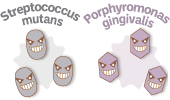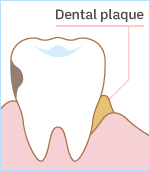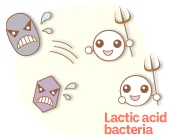|

Lactic acid bacteria and mouth bacteria
Let's support the good bacteria in the mouth
Just as you take good care of your skin and hair, it’s important to take care of your breathing.
There are bacteria living inside the mouth, in larger numbers than you might expect. So let’s learn how to look after the mouth properly.
We asked the following questions to Dr. Yasuhiro Koga, who is professor at Tokai University’s School of Medicine, and President of the Japanese Society for Probiotics Science, and also the scientist responsible for developing the OLL2716 lactic acid bacterium.
What types of bacteria live inside our mouths?
There are actually huge numbers of bacteria inside the mouth. Like the intestines have their intestinal flora, the mouth has its own colony of bacteria called “mouth flora.” And like the intestinal microbiota, the mouth flora also contains both good bacteria such as lactic acid bacteria and bad bacteria. The main type of bad bacteria is Porphyromonas gingivalis, which causes gum disease. This particular species of bad bacteria propagates by feeding off carbohydrates and protein, and eventually damages the gums and other surrounding tissue, causing inflammation. When bleeding is caused by the inflammation, the bacteria use the blood as nutrition to proliferate further. When this occurs, the mouth gives off that typical smell of rotting meat, which I’m sure you know. When your mouth reaches this stage, methane and hydrogen sulfide are produced, which cause a vile smell. If gum disease is left untreated and escalates, the teeth will eventually fall out of the gums. |
 |
 |
Where are mouth bacteria hiding?
P. gingivalis bacteria love feeding off the dental plaque inside the mouth, which is formed from the food residue that gets stuck between the teeth and the gums. Because they don’t like oxygen, they keep propagating inside the dental plaque, and develop into little dark colonies. Speaking of dental plaque, there is another type of bacteria called Streptococcus mutans, which is known to cause tooth decay. S. mutans bacteria feed off carbohydrates, form sticky matter around them, and produce a lot of lactic acid. When this acid comes in contact with the teeth, it dissolves the surface and causes cavities. While both can be prevented by careful brushing of the teeth, once the bacteria find their way into the mouth and settle between the teeth and the gums, they cannot be reached from outside and will cause trouble.
|
 |
 |
What else can I do besides brushing my teeth?
This is where lactic acid bacteria come to the rescue. The plan is to build up the good bacteria so that they can defeat the bad bacteria. And yogurt is a potent food for doing this, as it can be consumed conveniently in our everyday lives for the lactic acid bacteria. Of course, don’t forget that proper tooth-brushing is always the first line of defense against them.
|
 |

*This is an image of the lactic acid bacteria jointly developed by Dr. Koga and Frente Co., Ltd.
|
How do lactic acid bacteria affect the bacteria living inside the mouth?
Research shows that the population of lactic acid bacteria found in saliva dwindles with age; some surveys show that roughly 30% of those aged between 35 and 44 have gum disease, while the figure increases to 50% for those aged 55 and above*. So it’s important to constantly ingest new lactic acid bacteria to continuously support the good bacteria.
Previously, the mainstream thinking on how to deal with pathogenic bacteria was to administer antibiotics and sterilize them. However, nowadays lactic acid bacteria are viewed as a promising alternative antidote to bacterial disease. Analogous to “beneficial insects,” lactic acid bacteria perform their functions rather gradually, causing little harm to the environment or side effects to our bodies. These positive functions of microorganisms are called “probiotics.” I highly recommend integrating them into your dietary routine to keep your mouth and intestines healthy and thriving.
*Source: Survey of dental disease cases conducted in 2005 by the Ministry of Health, Labour and Welfare
 |





